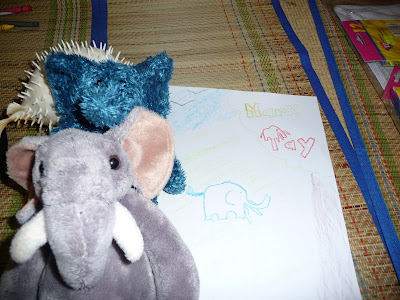
The stiff ends of the wild lalang grass (Imperata cylindrica) make good projectiles. To be exact, it is the midrib of the lalang that is launched when leaf blades on both sides of the midrib are rapidly ripped backwards between the fingers, causing the midrib to fly forward like an arrow. Uncle Si Guim shows the kids here how to launch such an arrow. Photo by Goh Si Guim.
During the Nature Society (Singapore) Get-Together on 1 November 2008, NSS Kids left behind their Playstations and XBoxes to go au naturale with games of yore.
At a time when Singapore was mostly kampongs and slums, toys were make-do improvisations of readily-available plant material like lalang and creepers of the wastelands and rubber fruits from disused rubber plantations. They were the source of endless enjoyment in Uncle Si Guim’s village (Lorong Ah Soo, circa 1970), where a little imagination went a long way in transforming these simple playthings into objects of fascination and great entertainment.
For example, the pointed fruits of the Thunbergia made excellent projectiles when ‘fired’ from a wooden rifle. The rifle itself was fashioned from wood to resemble the real thing, and Thunbergia bullets were propelled by kinetic energy from released rubber bands. The stiff ends of the wild lalang grass (Imperata cylindrica) also made good projectiles. To be exact, it is the midrib of the lalang that is launched when leaf blades on both sides of the midrib are rapidly ripped backwards between the fingers, causing the midrib to fly forward like an arrow. Lalang arrows and Thunbergia rifles thus became a game of Red Indians and Cowboys, emulating popular Westerns shown in the days of black-and-white TV.
 Uncle Si Guim lets a little boy try out the Thunbergia wooden 'gun', a favourite kampong toy. Photo by Gloria Seow.
Uncle Si Guim lets a little boy try out the Thunbergia wooden 'gun', a favourite kampong toy. Photo by Gloria Seow. The little boy's Thunbergia 'bullet' hits the cloth with some impact, but just beyond the target circle. Photo by Gloria Seow.
The little boy's Thunbergia 'bullet' hits the cloth with some impact, but just beyond the target circle. Photo by Gloria Seow. Fallen rubber fruits can be turned into a spinning toy by inverting its fruit walls and locking them together (bottom right of photo). The photo above shows both the rubber fruit's walls and seeds. Photo by Goh Si Guim.
Fallen rubber fruits can be turned into a spinning toy by inverting its fruit walls and locking them together (bottom right of photo). The photo above shows both the rubber fruit's walls and seeds. Photo by Goh Si Guim.The three-chambered rubber fruit has one seed encased within each chamber by a pair of earlobe-like walls. As the fruit dries and contracts, it builds up a great explosive energy and at some point, enough tension causes the two halves of each chamber to dehisce violently, dispersing the seeds some distance away. The fallen fruit walls, mirror opposites in structure, are usually still attached to each other by a thin strand of fibre. Kampong kids would then detach the two halves, invert one half over the other, and lock them in place with the help of a thin springy flap found on the fruit walls. Held gently between the thumb and the third finger, the new toy can then be blown, with the curvature in each half catching the wind and setting the contraption into a delightful spin. Kids were intrigued by the ingenuity of these simple toys, lovingly gathered and made by Uncle Si Guim.
Auntie Geok Choo and Auntie Gloria then taught the Kids how to play ‘Five Stones’, a game that required good hand-eye coordination to enable the precise throwing and catching of tiny, triangular cloth bags of rice or sand in a fixed sequence. A round of Chatek followed next, with Uncle Loong Fah expertly kicking the feathered device in a controlled fashion to keep it off the ground for as long as possible. Kids then started kicking the Chatek to each other in an impromptu match and had lots of fun doing so.
 Playing 'Five Stones', a game involving the throwing and catching of triangular cloth bags of rice or sand in a fixed sequence. Photo by Kevin Blackburn.
Playing 'Five Stones', a game involving the throwing and catching of triangular cloth bags of rice or sand in a fixed sequence. Photo by Kevin Blackburn.
 Playing 'Five Stones', a game involving the throwing and catching of triangular cloth bags of rice or sand in a fixed sequence. Photo by Kevin Blackburn.
Playing 'Five Stones', a game involving the throwing and catching of triangular cloth bags of rice or sand in a fixed sequence. Photo by Kevin Blackburn.Uncle Timothy then introduced the Kids to his childhood pastime of ‘Marbles’, where one marble is carefully aimed and thrown into a sandy pit full of marbles to knock as many of these out of the ring as possible. Children could be seen squatting around in small groups, engaged in a friendly rivalry for more marbles, reminiscent of a bygone era of kampong kids and their simple games.
 Kids enjoying the riveting game of 'Marbles'. Photo by Gloria Seow.
Kids enjoying the riveting game of 'Marbles'. Photo by Gloria Seow.
 Kids enjoying the riveting game of 'Marbles'. Photo by Gloria Seow.
Kids enjoying the riveting game of 'Marbles'. Photo by Gloria Seow.















 Volunteers and students in action!
Volunteers and students in action!